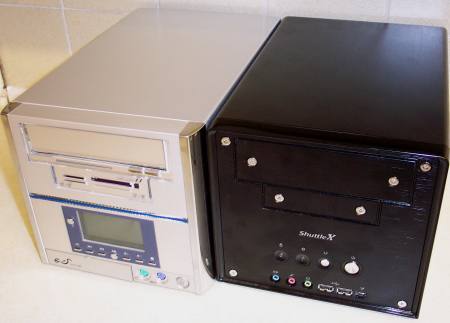Setup and notes
Here's a quick rundown of the test system should you wish to compare benchmark results with your own.- AMD Athlon 64 Model 3400+ Clawhammer CPU. RAM running with an 10 divisor (DDR400, single channel)
- Intel Pentium 4 3.2GHz ES 800FSB CPU
- EPoX Mini Me eX5-300S SFF System (17/10/2003 BIOS)
Other components
- ATI Radeon 9
Software
- Windows XP Professional
The shipping 15/10/2003 BIOS often caused booting problems when anything other than optimised defaults were loaded. Web-based flashing to the 17/11/2003 BIOS cured this problem. The Mini suffered from no further booting or stability problems. It ran overnight with a Radeon 9800XT and 2 hard drives attached. The PSU reiterated our belief that quality is often more important than pure wattage rating.
A semi-unlocked Pentium 4 3.2GHz CPU allowed us to explore the Mini Me's FSB limits. 265MHz FSB was extremely stable in Windows XP. I make note of this because the Mini Me often failed to start from a cold boot at > 240MHz FSB. Perhaps the immediate load and high FSB speed combined to cause problems. Suffice to say, it had no issues at the default 200MHz FSB.

The i865G chipset houses Intel Extreme Graphics 2. We found it to be extremely poor with respect to 2D work. Its 2 weak rendering pipelines and reliance on system memory to provide workable bandwidth resulted in barely denting our gaming benchmark suite. We've covered its 3D performance before, most notably with our look at Shuttle's RefleXion SFF system here. The numbers haven't changed significantly since then. We'd recommend users opt for a discrete AGP card of any variety. The Extreme 2's poor 2D and 3D performance isn't indicative of just how potent onboard graphics can be.
The Mini Me was benchmarked against Shuttle's similar SB65G2 SFF system and the performance-topping Athlon 64 3400+. Clock frequencies were as follows:
3207.7MHz - Intel Pentium 4 3.2GHz / Shuttle SB65G2 (Springdale i865PE)
3200.5MHz - Intel Pentium 4 3.2GHz / EPoX Mini Me eX5-300S SFF (Springdale i865G)
2210.9MHz - AMD Athlon 64 Model 3400+ / EPoX 8HDA3+ K8T800
Benchmarks were carried out at 1024x768x32 85Hz unless otherwise stated. They were also run three times. The highest and lowest results were discarded.

It's just a teensy-weensy bit bigger than Shuttle's XPC. Does it also perform that much better?. Let's find out.









